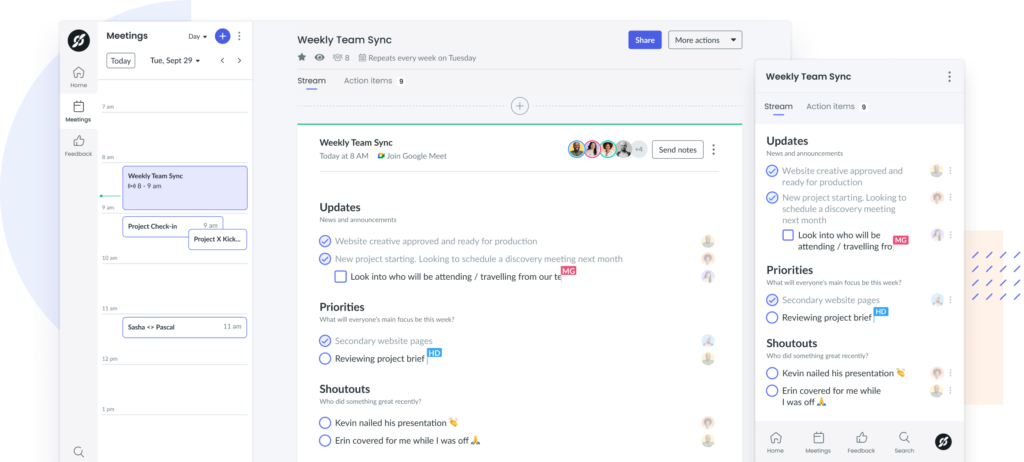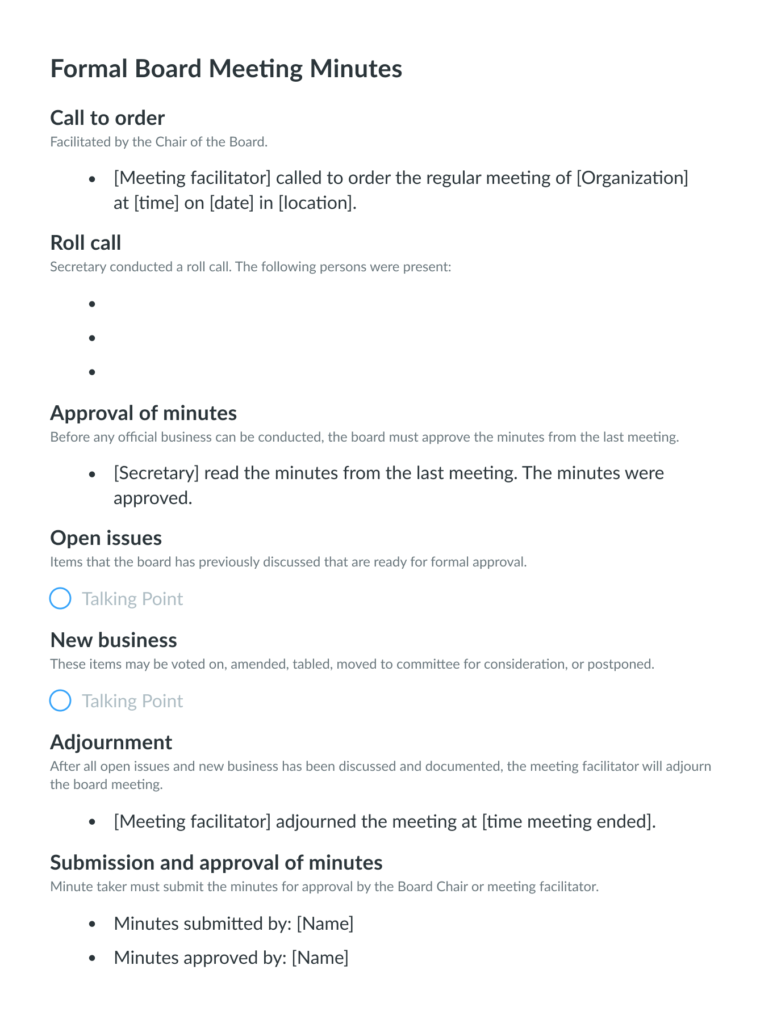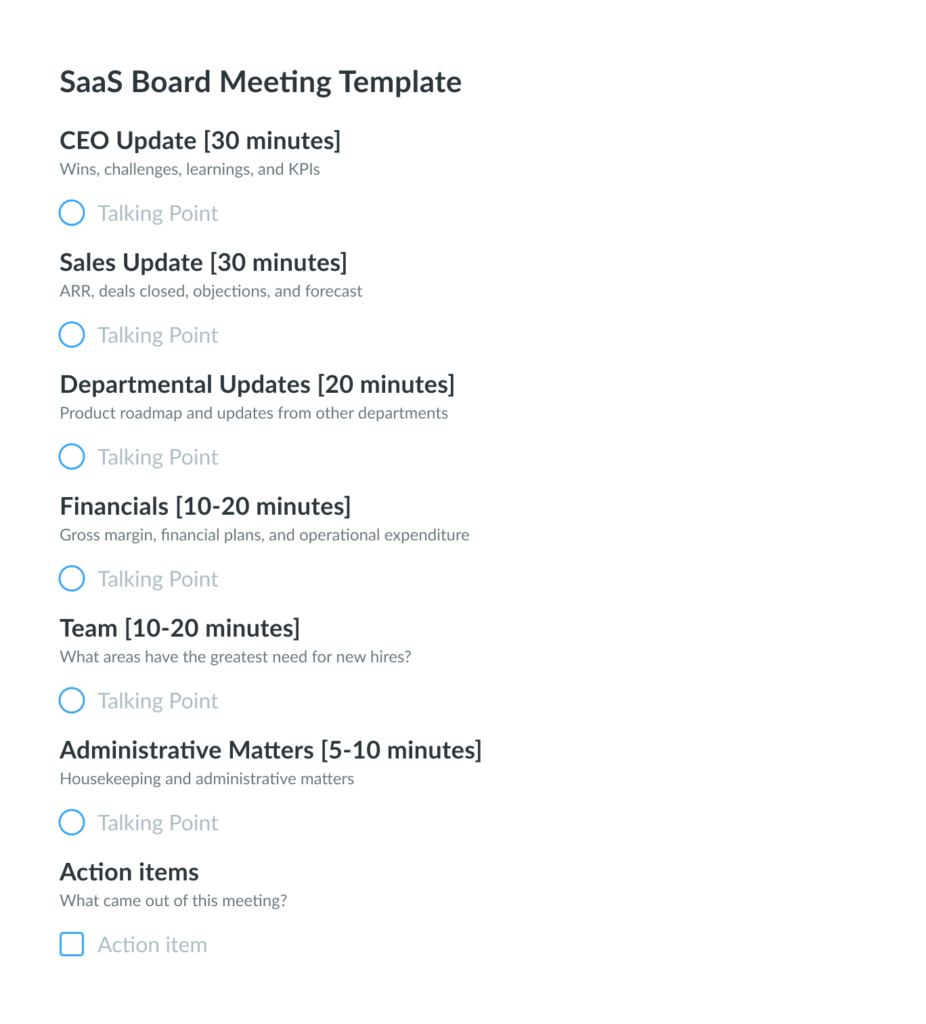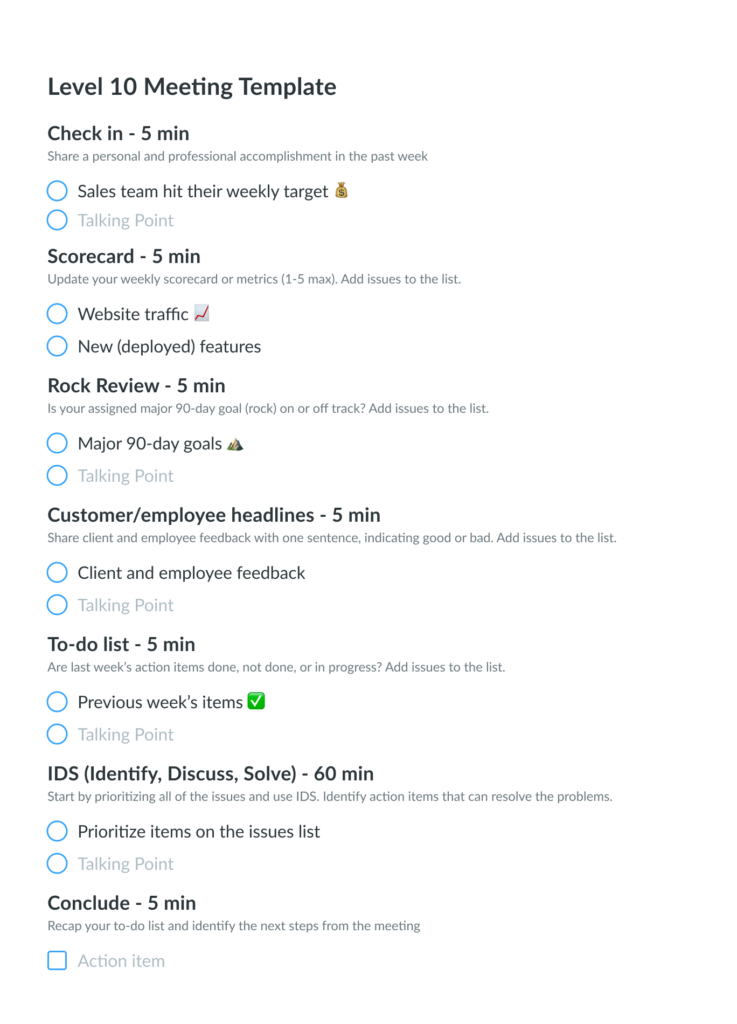Meeting Minutes Formats and Free Templates (+6 Best Practices)
Learn how to write effective meeting minutes so that you can ensure you and your team are recording the appropriate information and making the most out of your time.
Along with the use of a meeting agenda, any meeting is made more effective when you and your team are taking meeting minutes. Meeting notes are a powerful resource for teams and are an essential means to share and disseminate information throughout any organization. There are different minutes of meetings formats that you can use, depending on which important topics you’re discussing in your team meetings.
Effective meeting minutes keep you and your team members organized, efficient, and more effective in achieving your company goals. For that reason, this article is going to outline what meeting minutes are, why they’re important, what your meeting minutes should include, and some final tips.
- What are meeting minutes?
- Why are meeting minutes important?
- Who is responsible for taking meeting minutes?
- What should your meeting minutes include?
- Meeting minutes formats
- Tips to take minutes at meetings
What are meeting minutes?
Meeting minutes are a written record of the conversation and decisions that are made during a meeting. Meeting notes are applicable to any kind of group within a company, including a board meeting, where the participants involved include boards of directors. Notetakers should be present for any kind of meeting that requires a written record of the important topics discussed. This written record can then be used to either inform team members who were unable to attend, making them a source of information. They also keep track of decisions and action items that can be revisited in the future.
Why are meeting minutes important?
Meeting minutes are important for several reasons, but we’ve highlighted some key benefits:
Organization:
Meeting minutes provide a historical record of the company’s short and long-term planning. Because each meeting contains an objective or goal, the board or meeting participants can then use the meeting minutes as a record for future reference, to understand the progression that has been made. Meeting minutes allow you and your team to both track and monitor your goals and successes.
Clarity:
Meeting minutes serve as proof of why and how an organization came to certain decisions, providing an explanation behind each decision. These meeting minutes can then be used to clarify or answer any questions that arise, in reference to any key decisions that have been made.
Accountability:
Meeting minutes are important because they provide legal protection for the organization. Often due diligence is captured in companies’ meeting minutes as well as any legal conversations which can then be officiated and documented to confirm the ethical, fair practices of the organization. More than organizational accountability, meeting minutes provide clear action items so that you and your team members can hold each other accountable for the tasks that you are responsible for completing.
Who is responsible for taking meeting minutes?
The person who is responsible for taking the meeting minutes varies considerably. In board meetings, there is typically a secretary who is consistently in charge of transcribing the meeting and sending out the meeting notes. In less formal situations though, and especially for internal meetings, the manager should assign note-takers, preferable on a rotating basis, so that everyone takes turns with managing the responsibility.
What should your meeting minutes include?
- General details
- Who, where, and when
- Attendees
- Meeting goal
- Business from the previous meeting
- New business or topics
- Next steps
- Adjournment
- Documents to be included in the report
1 General details
Before you start writing your meeting minutes, note the date and time of the meeting. Seems intuitive enough, but it’s worth a mention seeing as it’s so important to be able to go back to previous meetings and understand when they happened, what’s been accomplished, and what’s still outstanding.

Pro tip
Use a meeting management tool like Fellow so the general details, like the meeting date, time, and attendees formulate automatically, making it easier to document important information.

2 Who, where, and when
Make sure to take note of when the meeting was called to order, the location of the meeting, who called the meeting to order, if it was in person or if you had virtual participants. These details will help add context to your meeting minutes, especially for people who were unable to attend.
3 Attendees
The next step is to document the names of all of the participants and any other people who weren’t able to attend. It’s a good idea to print and use the calendar invite to check names as participants join or enter the room. If you use Fellow to build your meeting agendas and write meeting minutes, your attendees show up automatically, so that you have one less thing to worry about.
4 Meeting goal
It’s pretty important that the “why” behind this meeting is documented and made obvious. In this part of the meeting minutes, try to be detailed in explaining why this meeting was called and what it’s trying to achieve. This is going to be especially useful for any individuals who were unable to attend the meeting and for anyone who is using the outcomes of this meeting to fuel decisions.
5 Business from the previous meeting
Review action items from the previous meeting that have not been completed yet. Understand what’s been completed, what hasn’t been, and why. This is a good time to learn about any obstacles or issues that stand in the way of achieving the meeting goal.
6 New business or topics
Add new action items and assign them to specific individuals, with specific deadline dates. Where there are new topics to discuss, be sure to set some time aside in your meeting agenda to discuss them. Often new business means realigning goals, timelines, and budgets, so be sure to account for the time that you need in order to remain efficient.
7 Next steps
Clearly outline the next steps to be taken through assigning new action items and in explaining what’s to come in the next few weeks. It’s important for the meeting participants to know when the call to order for the next meeting is, with regard to this project or topic of discussion. This gives you a general timeline of how long you have to complete the responsibilities that have been assigned to you. Next steps can be documented as action items in your Fellow.app meeting note.
8 Adjournment
To adjourn the meeting is to suspend proceedings to another time or place. This signals that everything that you and your team were able to accomplish, was accomplished. Anything and everything else can be revisited in another meeting after some time and attention has been given to those areas of the business.
9 Documents to be included in the report
The last thing to include are supplementary documents that you should send out with your minutes in the meeting report. Think about if any documents were used or referenced in the meeting which may be useful to include for your team members. This could include an action or issues log, KPIs, updates or changes to the project.
Meeting minutes formats
Because there are different minutes of meetings formats, we’ve got you covered with a few examples below:
Formal Board Meeting Minutes Template
Check out our template for a formal board meeting below:

SaaS Board Meeting Template
Check out our SaaS board meeting template below:

EOS Compatible Meeting Minutes Template
Check out our EOS Compatible meeting template below:

You can find 500+ meeting minutes templates in our template gallery!
Tips to take minutes at board and member meetings
- Follow the same structure
- Take minutes in real time
- Record important decisions
- Stay objective
- Share them with stakeholders outside the meeting
- Make past minutes easily accessible
1 Follow the same structure
Once you find something that works for you, follow the same structure when writing your meeting minutes. The meeting agenda will show you what needs to be discussed during the meeting, which you can use as an outline, with each agenda item as a sub-topic where you can add more specific notes. If similar meetings have taken place before, you can use previous meeting agendas as a template in order to begin taking your minutes with some structure already in place. Using a strong meeting agenda template will help you create consistently structured and sufficiently detailed minutes.
2 Take minutes in real time
It’s a good idea for meeting note takers to write the minutes down in real-time, as the meeting unfolds. When you write your meeting minutes in real-time, you’re going to capture the most realistic representation of the meeting. Sometimes, it’s difficult to recall everything that was discussed, the decisions that were made, and the action items that need to be completed for the next meeting. That’s why it’s important to capture information and key decisions as they unfold.
3 Record important decisions
Be sure to document the decisions made at any meeting, especially in meetings where people take a vote. Be sure to record all motions and outcomes of votes. Record the number of votes and if possible, add some detail for context so that you can also record the motives behind the decisions. Assigning action items to different team members is also an important decision to document. Record action items as soon as they happen so that you can transcribe them with accuracy. This helps hold each other accountable for your responsibilities and support one another in getting tasks done.
4 Stay objective
A good rule of thumb is to keep your meeting minutes as objective as possible. Make sure the minutes of the meeting include language that is clear, unambiguous, and complete. It’s important to write your meeting minutes in a neutral voice, avoiding adjectives and adverbs where you can to avert bias as much as possible. While you’re entitled to your opinion, you don’t want to sway the opinions of others. Remaining neutral and unbiased allows your team members to come to their own conclusions and bring a unique voice to the table.
5 Share them with stakeholders outside the meeting
Meeting minutes are a powerful resource for teams and are an essential means to share and disseminate information throughout your organization and companies that you’re working with. This is why even when clients or stakeholders aren’t attending your meetings, you send them a copy of your meeting minutes, to keep them in the know with the latest news and developments. So long as the meeting minutes directly concern your stakeholders, they will be grateful to have this additional resource shared with them. Be sure that the appropriate person has approved the minutes before you share them outside of the organization.
6 Make past minutes easily accessible
The minutes from previous meetings can and should be used in order to make future organizational decisions. It’s so important to be able to go back to previous meetings and understand when they happened, where they happened, who attended, what’s been accomplished, and what’s still outstanding. This information should be easily accessible to your team members. When you use Fellow, the app helps you store previous and current minutes all in one place to keep you as organized as possible.
Parting advice
Productive meetings cannot remain productive without a record of what has been discussed and what kinds of decisions have been made. Using different formats and templates of meeting minutes will save you valuable time and encourage your team to work more effectively together. Whenever you need a reminder as to how to go about managing and writing successful meeting minutes, refer back to this article as a refresher. Even better, try out one of our different minutes of meetings formats and let us know what you think. Until next time!











